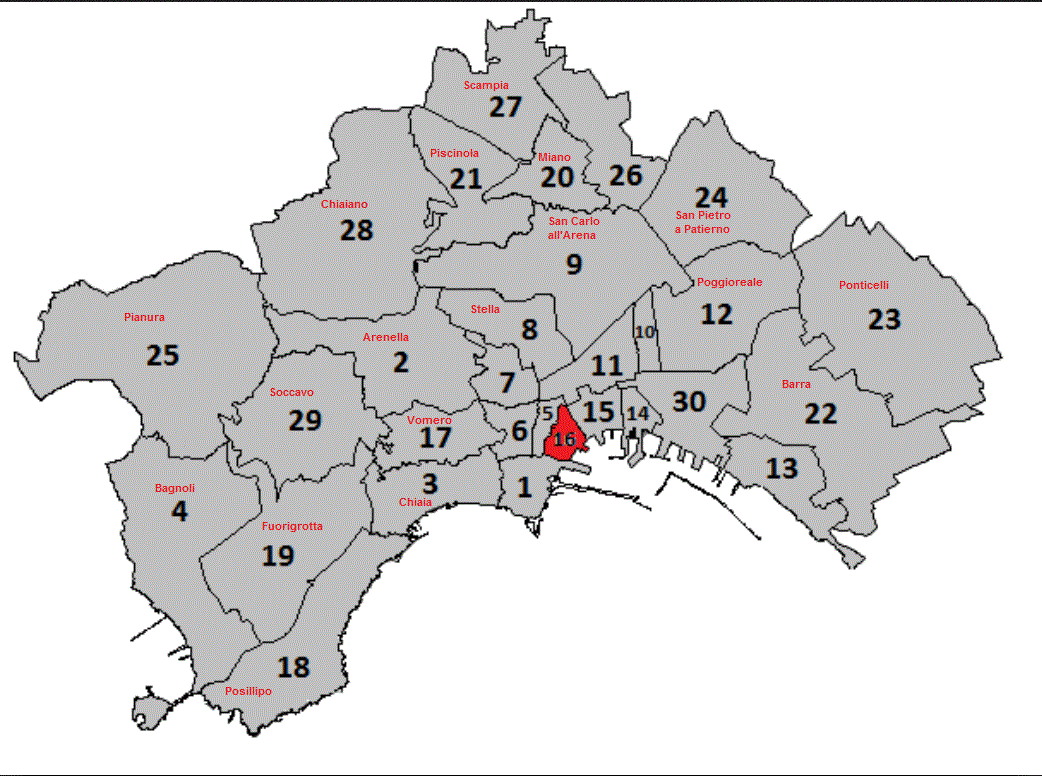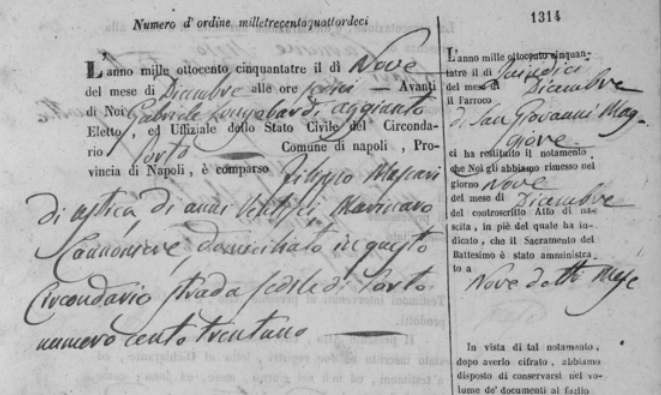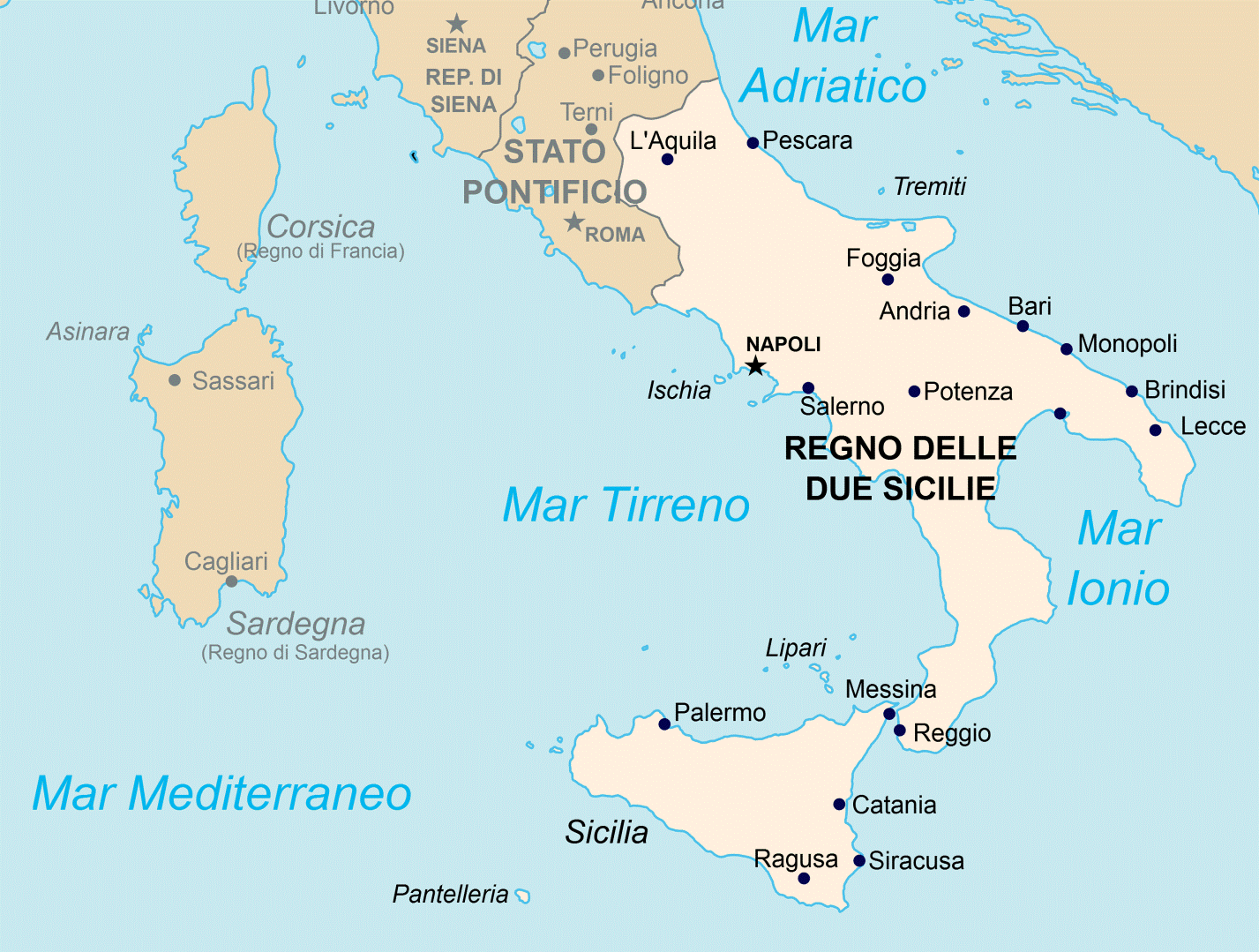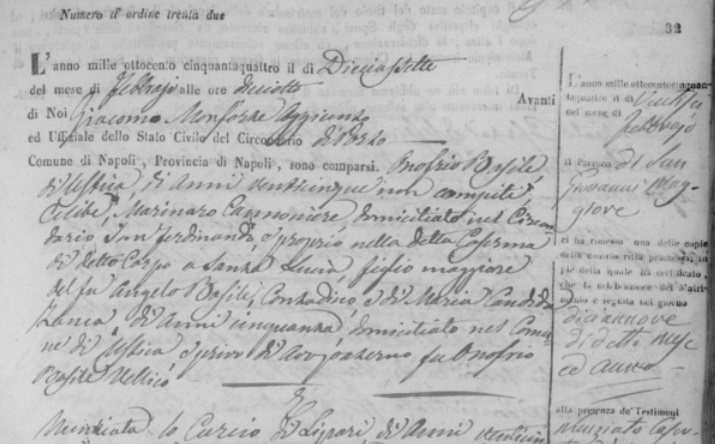
The 30 circondari of the city of Naples with Porto highlighted in red. |
If you visit the What's New! section at the UGH, under April 2016 and May 2016 you'll notice that I added a lot of records from the city of Naples from roughly 1843 through 1862. I have a personal interest in this research because the Caravella family (3 generations in tow) picked up and left Ustica around 1845 and lived in Naples for the next 15 years. Most of them returned to Ustica by 1865. But, I already had learned that there were many other Usticesi living in Naples during this time period. I knew this from birth locations recorded in the Ustica civil records and from supplemental records. Supplemental records in the Ustica stato civile were added to the end of each year's records and are the re-registration of civil records from communities outside of Ustica for acts of marriage, birth or death involving Usticesi living in these areas. Supplemental records aren't comprehensive and appear to be done only if the families still had some stake in Ustica and wanted to have their family status properly documented. Still, supplemental records are key to discovering where Usticesi were migrating and setting up colonies both within Italy and abroad. Such is the case with Naples and, to be exact, just one neighborhood in Naples, the circondario Porto.
Porto is one of 30 circondari making up the city of Naples. For genealogists, the city has always been a challenge because of its immense size and also because there is no comprehensive index of civil records across the city like there is with Palermo. Even the Mormons, those energetic collectors of genealogical records worldwide, were challenged by this as the records for Porto and some other sections of Naples were not even available in their catalog of microfilms. But the world of genealogical records is ever changing in light of fast-paced internet and scanning technological advances. The Italian archives (Sistema Archivistico Nazionale) and the Latter Day Saints (Mormons) have teamed up to tackle the problem. The Mormons (and their trove of volunteers) are completing the scanning and registration of records that were missing from their microfilm inventory and, in return for access to the records, they have built an internet portal for the Italian archives. And, unlike much of the Mormon digital archives which are only available at Mormon facilities, the portal of the Italian Archives is free and open to the public from any internet-accessible device.

The 30 circondari of the city of Naples with Porto highlighted in red. |
True to Mormon genealogical sympathies, they are also creating a searchable index to the digitized records. This is being done for records all across Italy but fortunately for this effort, Naples has been an early area of focus (-- to answer the obvious question - No - Ustica, and much of Sicily for that matter, is not yet available --). Porto records are not yet part of the searchable index, so it is a pain-staking process to flip through the tens of thousands of records looking for people "di Ustica". As tedious as this is, it is still the best way to capture comprehensive results, because even if the Porto records were indexed, nativity is not one of the searchable items. To give you an idea of how large an effort this is, there are typically about 1,300 births per year in Porto. Expand that out for the 20 year period I was interested in and you've got 26,000 birth records just for this one circondario in Naples! There are only about 1,500 birth records for Ustica during that same time period.

Filippo Mascari of Ustica declares the birth of his daughter in Porto 1853. |
My focus had originally been on finding the birth records for my great grandfather and four of his brothers who were also born in Naples. I had exact dates for three of them but the other two would require looking through a ton of records. By the time I found all 5 (plus an additional one for one of the wives, a Verdichizzi who was also born in Porto), I had rummaged through roughly 2,025 birth records and, of these, I also found 54 records of other Usticesi families. That's a significant amount of birth records considering what the size of the population of Ustica itself was at the time (~4500) and how apparently large the population of Porto was. With my curiosity peaked, I also searched the marriage records from 1842 through 1853 finding 58 marriages involving Usticesi. That was a little easier since most of the marriage records have a yearly index. I also expanded the birth search to include 3 complete, consecutive years, 1853-1855. I found a total of 78 births involving at least one Ustciesi parent in just this three year period. Usticesi men were also showing up as witnesses to some of these births and marriages. This is further evidence that they kept together as a community bound by their hometown connections. With this data set, I had identified a significant population of Usticesi in Porto and could begin to draw out reasons for the anomaly.
It seems strange to image a time when Italy was not just a single unified country, but that was the case for most of the area's history up until the unification of Italy in the mid 1860's. Prior to that, Naples was the capital of the Kingdom of the Two Sicilies which included the southern part of the "boot" of Italy and the island of Sicily, which includes Ustica. We also know that during this time period, Ustica was reaching the peak of its historic population.

Kingdom of the Two Sicilies with its capital at Naples. Ustica is the blue speck north of Palermo. |
This was far more than the tiny island could sustain and it's during this period that we begin to see the migration of Usticesi away from the overcrowded island. Why many went to Naples becomes apparent when examining the occupations listed for Usticesi men in Porto. Of the 87 Usticesi men that occur in the data set, 59 are listed as "marinaro cannoniere" which translates as naval artilleryman or navy gunner. So migration to Naples seems to have been driven by enlistment in the military, in this case the navy which was based in Naples. I had always assumed a military enlistment was a guaranteed single life for males, but this does not appear to be the case in Italy for this time period. We see Usticesi naval artillerymen marrying in Ustica before deployment to Naples as well as marriages in Naples to both Neopolitan women and Ustcesi women living in Naples. The latter indicates that not just the enlisted men were moving to Naples but sometimes their families were moving along with them. This may be the case for the Caravella family. While none of the Caravella males in my branch of the family are listed as naval artillerymen, the family of the matriarch, Margherita Trimoli Caravella, was also in Naples and her brother was a corporal of the naval artillerymen. It is plausible that the Caravellas were looking for opportunity away from crowded Ustica and found it a convenient and safe choice to move in with the Trimoli family already in Porto.
Another interesting aspect of examining the Porto records by nativity is that we get an idea of where migrants to Porto were coming from. Here too, Ustica is over-represented. We see people coming from larger cities like Messina, Palermo and Lipari and areas nearby Naples like Procida, Ischia, Castellamare, Sorrento and Positano. But, not much more than that. Ustica is definitely the oddball in that list and again is probably reflective of that push to migrate from the island driven by overpopulation and the lack of opportunity that comes with it. Usticesi were particularly good at addressing a problem (lack of opportunity), sharing the solution (enlist in the navy) and then supporting the rest of the community that adopted that decision (develop a community at Porto). So good, in fact, that time and again Usticesi are over-represented in their adopted communities (in size, documentation and influence) in comparison to their relative size back home on the island. Of course, there very well could be other social/political reasons for why Ustica seems over-represented in the navy and in Porto, but these reasons are rarely evident in genealogical records. I do get a sense that 19th century Italian class structure may also be playing a role. There is an obvious lack of the largest families from Ustica, in particular the Bertucci and Tranchina families. These families in Ustica tend to be the landowners and many family members are titled, that is, they have Don or Donna preceding their names in Ustica civil records. A naval military career could have been one of those opportunities more suited to the middle and lower classes in Italian society, those people being the barbers, shoemakers, fieldworkers, fishermen and such. Ustica's status as an internment camp for political dissidents also could have come into play. Such an operation had high visibility within the government and attracted a military presence and many more government functionaries than would be expected in a typical Sicilian town. That influence could have opened opportunities to serve in the military for the local population.

Onofrio Basile of Ustica marries Nunziata Lo Curcio of Lipari in Porto 1854. He is living in circondario San Ferdinando (# 1 on the previous map of Naples) at the barracks of Santa Lucia. His parents are living in Ustica. |
The civil records of Porto also further tie Ustica to an important naval battle in 1866. Three Usticesi men who died in the Battle of Lissa show up in the supplemental records of Ustica in 1868. (You may recall that a few years back the CSBA, working with Fred Laurice of California, raised money to have the three men commemorated at a monument in Ustica dedicated to the those fallen in battle.) The battle of Lissa took place after the Italian unification at a time when the new Italian state was trying to recover Venice from the Austro-Hungarian Empire. It was a disaster for the Italians and many men lost their lives. One of the three Usticesi men was Antonino Caravella, the son of Pasquale Caravella and Maria Zanca. Antonino Caravella also shows up in the Porto birth records as the father of Maria Luigia born there in 1855. So with this one record, we can tie his tragic death in an infamous naval battle to the community of naval artillerymen from Ustica living in Naples. That was a rather fortunate find considering the narrow range of birth records that were searched. Residency for naval artilleryman in the civil birth records also can sometimes indicate their deployment status. Residency is very specific giving the actual street and address where they were living. Most just live in the neighborhood but some live in the "caserma" (barracks) and, those presumably deployed on a mission or naval exercise are listed as "fuori Napoli" (away from Naples).
With the release of the Naples civil records online, we can freely explore another exciting and interesting chapter in the history of the Usticesi community. The circondario Porto in Naples served as a base for the community of Usticesi naval servicemen and their families in the mid 1800�s. This research provides another great example of how genealogical research can reveal more than just family lineage and shed light on important historical and cultural trends in the migration of Usticesi throughout the world.
Link to the Naples records: Sistema Archivistico Nazionale